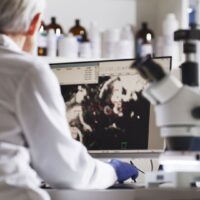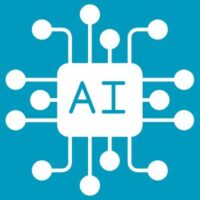Artificial intelligence is hot. The rise of OpenAI has put artificial intelligence on the map, and more and more groundbreaking discoveries made with the help of AI (artificial intelligence) are being shared in the news. We wondered: could AI mean something for laboratory animals? In this article, we dive deeper into the wonderful world of AI – and more importantly: how it can replace animal testing.
What is AI?
Let’s start with the basics. AI stands for artificial intelligence. It involves developing computer systems that, with the help of existing data and algorithms, can learn and perform tasks without human assistance. Well-known examples of artificial intelligence include Alexa and Siri, two machines that many people use in everyday life. For instance, to explain what AI is!
How AI can contribute to lab animal-free research according to ChatGPT
ChatGPT is an artificial intelligence chatbot developed by OpenAI. The chatbot has been refined with learning techniques, allowing it to engage in dialogues with users. It was therefore obvious for us to ask ChatGPT how AI could help make animal testing redundant.
The answer is promising, as according to ChatGPT: “AI (Artificial Intelligence) can play a significant role in reducing the use of laboratory animals in scientific research.” Not only that – the chatbot also provides us with various ways AI can contribute to our mission.

Ways AI can contribute to lab animal-free research according to ChatGPT:
- In silico research (computer models): AI can enable advanced computer models and simulations, allowing researchers to study biological processes without using laboratory animals. This enables scientists to conduct in silico experiments where AI models predict the effects of certain substances on biological systems.
- Data analysis and pattern recognition: AI can analyze large amounts of data and identify patterns that were previously difficult to recognize. This can help researchers better understand how certain substances react in complex biological systems, without conducting actual animal tests.
- Genetic modification and synthetic biology: AI can be used to design and optimize genetic modifications. This allows researchers to map and manipulate genetic traits without the need for animal testing.
- Robotics and automation: Robots equipped with AI can be used to perform repetitive tasks in the laboratory, giving researchers more time for complex analyses and experiments. This reduces the reliance on laboratory animals for routine tasks.
- Biomarkers and diagnostic tools: AI can help identify biomarkers and develop diagnostic tools that can track diseases and treatment effects without the need for laboratory animals.
- Virtual reality (VR) and augmented reality (AR): VR and AR can be used to create virtual models of biological systems, allowing researchers to conduct experiments in a virtual environment without using actual laboratory animals.
The benefits of AI in research
There are many advantages to using AI in scientific research. Scientists have managed to develop AI models that closely mimic human cognitive abilities. These models can process large amounts of information and thus make accurate predictions.
Such models are used at TNO by Gino Kalkman and Jennifer Venhorst. They use AI models to analyze vast amounts of existing data from past research. Jennifer says, “The more you can make use of the data that is already there, the fewer animal experiments will be needed. In developing new medicines, both the therapeutic rationale and the risks need to be mapped out. To avoid unnecessary animal testing, we have set up a system using AI that helps with this. This system analyzes existing literature and finds out if and how potential drug targets (proteins) contribute to desired therapeutic effects or cause side effects. Not only direct relationships between a protein and effect are studied, but also the broader network in which such a drug target (protein) is active is mapped.”

Jennifer Venhorst © TNO
Join our LinkedIn group
The Animal Free Gallery is your platform to share successes, exchange knowledge, and network with like-minded professionals and scientists. Together we can make strides towards innovations without animal testing. Join us and celebrate every development towards ethical and innovative research!
AI in lab animal-free research
We invest in research that uses AI to make animal testing redundant. An example is the MechPath project. This unique collaboration of various parties brings together existing innovations and data to arrive at new insights that can lead to better medicines and treatments. Currently, this project focuses on liver fibrosis, a condition in which scarring impairs liver function.
Prof. Gerard van Westen works on MechPath at Leiden University and explains how they use AI in their project: “Fibrosis in the liver can arise from various causes. We use AI to analyze and understand these causes. Next we combine AI with animal-free models in the lab to predict the disease pattern of fibrosis in different patients. With this method, we can simulate the patient, so to speak, and thus devise and investigate better treatments.”
When asked whether AI could make animal experiments permanently redundant, Gerard cautiously answers positively: “At this moment, I do not see AI making all animal experiments redundant. There is a big gap between ‘we think this is a safe and effective medicine’ and ‘we are convinced that we can give this medicine to people.’ That gap is largely unknown: the unknown unknowns are the problem. To bridge this gap, an animal is still used. But I think replacing these animal experiments is eventually possible; I just can’t say when.”

The challenges of AI in research
Using AI is not without challenges. Despite the great strides AI is making, there are still challenges. For instance, AI currently depends on available data. If this data is not available or is unreliable, then the computer will not be able to provide reliable results.
An example is the use of AI in toxicology. We now have enough data for an AI model to predict whether a substance is toxic or not. But unfortunately, we still do not have enough data about the biological processes that occur in our bodies. Therefore, an AI model cannot always accurately predict how our bodies will react to certain substances—whether toxic or not.
Finally, it is not always clear how AI works exactly. The algorithms AI uses to make predictions can be so complicated that even scientists do not understand what the computer has done to come to a prediction. And because of this, the predictions made are not always trusted.
“The predictive value of a model can decrease if there are too many factors or combinations of factors involved. AI is fed with things we know; but not necessarily with things we understand. The result is that AI can come to conclusions that we do not understand,” says Prof. Chris Evelo from Maastricht University. Within the Virtual Human project, Chris works with computer models on the bioinformatics of the project. “And that makes it difficult to explain why something does or does not work. For example, patients will not easily accept it if a medicine is used in others but not in them, just because AI advises against it.”

AI needs time and trust
Computer models and AI models have been used in scientific research for many years. The rapid development of artificial intelligence offers enormous opportunities for animal-free research—but we must not rush.
It can take a long time before AI can actually make animal experiments redundant. Jennifer Venhorst of TNO explains: “At this moment, we are not there yet, but significant steps are being taken. More and more often, complex, human systems are used in research, such as organs-on-chips. If this goes hand-in-hand with AI, I think we will eventually reach a point where we can make animal experiments redundant. But that is still a long way off.”
“Trust in AI is also a factor,” says Anne Burgers, our science and innovation advisor. “The use of AI both within and outside of science still raises doubts among many people. How much impact AI can actually have on the use of laboratory animals will only be discovered once there is more trust in animal-free innovation.”
Thus, AI has great potential in accelerating the development of animal-free methods, but there is still work to be done—we are further along than you might think.


